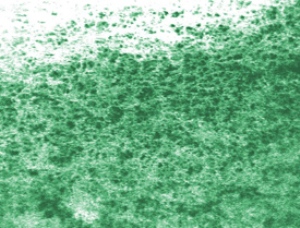Researchers have developed a drug delivery technique for diabetes treatment in which a sponge-like material surrounds an insulin core. The sponge expands and contracts in response to blood sugar levels to release insulin as needed. The technique could also be used for targeted drug delivery to cancer cells.
 The sponge-like matrix surrounds a reservoir of insulin or other drugs. Image: Zhen Gu
The sponge-like matrix surrounds a reservoir of insulin or other drugs. Image: Zhen Gu
“We wanted to mimic the function of health beta-cells, which produce insulin and control its release in a healthy body,” says Dr. Zhen Gu, lead author of a paper describing the work and an assistant professor in the joint biomedical engineering program at North Carolina State University and the University of North Carolina at Chapel Hill. “But what we’ve found also holds promise for smart drug delivery targeting cancer or other diseases.” The research team includes Daniel Anderson, the senior author and an associate professor of chemical engineering and member of the Koch Institute for Integrative Cancer Research at MIT, and researchers from the Department of Anesthesiology at Boston Children’s Hospital.
The researchers created a spherical, sponge-like matrix out of chitosan, a material found in shrimp and crab shells. Scattered throughout this matrix are smaller nanocapsules made of a porous polymer that contain glucose oxidase or catalase enzymes. The sponge-like matrix surrounds a reservoir that contains insulin. The entire matrix sphere is approximately 250 micrometers in diameter and can be injected into a patient.
When a diabetic patient’s blood sugar rises, the glucose triggers a reaction that causes the nanocapsules’ enzymes to release hydrogen ions. Those ions bind to the molecular strands of the chitosan sponge, giving them a positive charge. The positively charged chitosan strands then push away from each other, creating larger gaps in the sponge’s pores that allow the insulin to escape into the bloodstream. In type 1 and advanced type 2 diabetes, the body needs injections of insulin, a hormone that transports glucose – or blood sugar – from the bloodstream into the body’s cells.
As the insulin is released, the body’s glucose levels begin to drop. This causes the chitosan to lose its positive charge, and the strands begin to come back together. This shrinks the size of the pores in the sponge, trapping the remaining insulin.
While this work created hydrogen ions by using enzymes that are responsive to glucose, the technique could be simplified to target cancers by eliminating the enzymes altogether. Tumors are acidic environments that have high concentrations of hydrogen ions. If the sponge reservoir were filled with anticancer drugs, the drugs would be released when the chitosan came into contact with the hydrogen ions in tumor tissues or cancer cells.
“We can also adjust the size of the overall ‘sponge’ matrix as needed, as small as 100 nanometers,” Gu says. “And the chitosan itself can be absorbed by the body, so there are no long term health effects.”
In tests using diabetic laboratory mice, the researchers found the sponge matrix was effective at reducing blood sugar for up to 48 hours. However, the researchers published a separate “smart system” for insulin delivery in May that maintained normal blood sugar levels for 10 days.
“But we learned a lot from the promising ‘sponge’ research and will further optimize it. Meanwhile, we are already exploring applications to combat cancer,” Gu says.
The paper, “Glucose-Responsive Microgels Integrated with Enzyme Nanocapsules for Closed-Loop Insulin Delivery,” is published online in ACS Nano. The research was supported by a grant from the Leona M. and Harry B. Helmsley Charitable Trust Foundation, and a gift from the Tayebati Family Foundation.
Source: http://www.ncsu.edu/